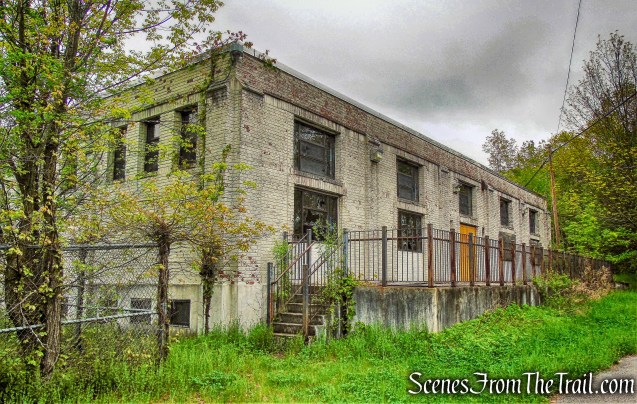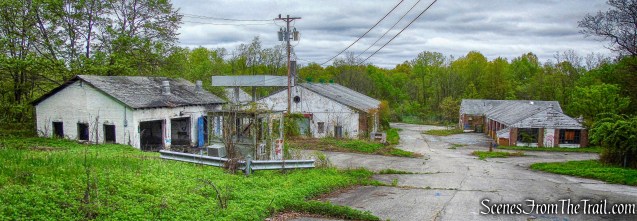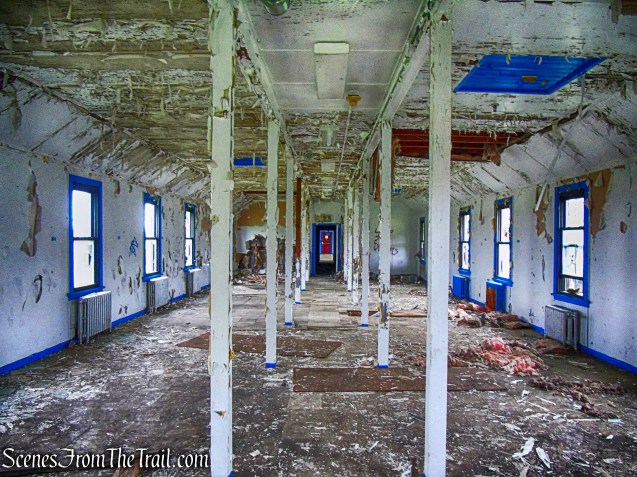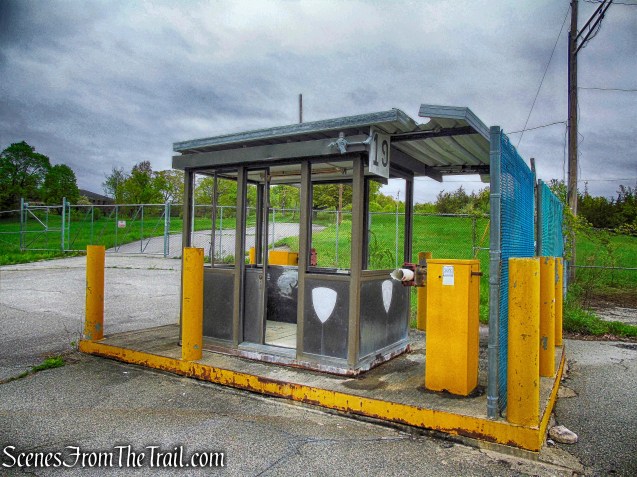May 13, 2018 – Chester, NY
Disclaimer: Exploring abandoned and/or ruined structures can be dangerous and you could be trespassing. Should you choose to enter the property of any of the places featured on this site, do so legally.
Camp LaGuardia straddles the towns of Chester and Blooming Grove. Built in 1918, the complex first served as Greycourt, a women’s penitentiary. After a sharp spike in the criminal activity of young women in New York City during and after World War I, the Women’s Farm Colony in the Town of Chester, Orange County, NY, received its first female inmates in 1924. A decade later, criminality among women was on the wane. But now, it was the depths of the Depression, homelessness and alcoholism among men were rampant.

Camp LaGuardia
In response, the city repositioned the property, shut down the prison, transferred title from the Department of Correction to the Department of Welfare, and in 1934, cut the ribbon for Camp Greycourt.

Camp LaGuardia
Mayor Fiorello LaGuardia was facing staggering poverty and unemployment. He loved the idea. He called the camp a “human repair shop,” and testified at federal hearings that 40% to 50% of residents left for full-time work. In 1935, the New York Times detailed the story of 28-year-old Ralph Rinaldo, former resident of New York’s skid row: “City Camp Farmer Wins Job and Wife,” read the headline. “Weds Onion Grower’s Daughter – Couple Get Gift of a Goat, a Pig and a Sheep.” A year after the camp opened, its residents voted to name it for LaGuardia.

Camp LaGuardia
The 1,001 bed camp was such a showcase of progressive thought that a scale model was exhibited at the World’s Fair. It is a collection of a half-dozen buildings, centering on the austere brick headquarters of Greycourt Prison and set on 258 acres of black soil.

Camp LaGuardia
After the Depression, older alcoholics replaced the merely out-of-work. It was a long-term place to be safe for Bowery drunks, healthier than the streets and cheaper for the city than jails. The place seemed to survive because it attracted so little notice.

Camp LaGuardia
That ended in the 1980’s. Drugs had transformed street life in New York. As mental hospitals closed, chronically ill men joined the ranks of the homeless. Chester homeowners began to complain about finding syringes on their lawns, and police made regular sweeps of the camp, frequently finding fugitives. In 1999, as part of a settlement with Orange County, the city turned the facility over to Volunteers of America, which imposed tougher screening and safety measures. In 2002, for the first time, a fence was erected around the camp’s perimeter.

Camp LaGuardia
As crack cocaine overtook booze as a drug of choice for the homeless, the shelter became an incubator for criminality, muggings took place along the old Erie Railroad tracks, and public lewdness and narcotics in the area were all too common.

Camp LaGuardia
Camp LaGuardia became the city’s single biggest shelter for homeless adults. At full capacity, the facility was nearly a third of the size of the Village of Chester.

Camp LaGuardia
Relations between the city and local communities began to fray as encounters between locals and camp residents, who would walk daily to Chester’s stores, grew ominous. Increased complaints of lewdness, harassment and public drunkenness prompted crackdowns by local police. Calls for greater oversight at the camp intensified in 1994, after a resident strangled a pet rabbit in front of a Greycourt Road woman.

Camp LaGuardia
Prompted in part by the changing demographics of the camp, as well as, the aforementioned incidents, local opposition to the facility grew throughout the 1980’s until its closing.

Camp LaGuardia
The closure of Camp LaGuardia was announced in November 2006 by New York City officials as part of Mayor Michael Bloomberg’s five-year plan to reduce homelessness in New York City. In 2007 the Bloomberg administration began moving camp residents to subsidized housing or other shelters in preparation for the decommissioning. The facility was closed in 2008 and the buildings have remained empty since.

Camp LaGuardia
The now abandoned campus consists of roughly a dozen structures, including the three-story, 70,836-square-foot Main Building, an East Barracks and a West Barracks, plus a Warehouse Building, Fuel Depot Building, Pump House and Recreation Building.

Camp LaGuardia
There are access roads leading both to the Main Building and some outbuildings, including LaGuardia Road, a winding roadway that accesses the complex from Greycourt Road.

Camp LaGuardia
Orange County purchased the campus for $8.5 million in 2007.

Camp LaGuardia
County efforts to market the property were a disaster. In 2008, the county authorized its sale for $8.5 million to Scarsdale-based Mountco Construction Corp., who initially planned to build 807 homes or apartments and 170,000 square feet of commercial space on the site.

Camp LaGuardia
For eight years, those plans were debated, contested and downsized. Everything from sewerage infrastructure to housing scale and quantity were fought over. Still, Chester and Blooming Grove balked, and absent their approvals, the project went nowhere.

Camp LaGuardia
In June 2016, the county paid Mountco $1.2 million to break the contract of sale, kill the long-stalled deal and basically buy back the development rights.

Camp LaGuardia
Department of Public Works crews began cleaning up the property in 2016. They cut away overgrown brush, cleaned the interior, and secured the buildings. An effort to make the property presentable for real estate brokers to show the site to potential commercial owners.

Camp LaGuardia
The century-old buildings of Camp LaGuardia are abandoned and run-down. Stripped by vandals, scorched by arsonists, neglected by owners and battered by Mother Nature.

Camp LaGuardia
Thanks to sturdy support beams and load-bearing walls, built-to-last design and stolid civic architecture, the old buildings have remained structurally intact.

Camp LaGuardia
Orange County is now intensifying its efforts to sell the undeveloped site.

Camp LaGuardia
Orange County officials have been waiting 10 years to get these parcels back on the tax rolls and have already lined up some interested businesses through their Orange County Partnership connections and the IDA (Industrial Development Association).

Camp LaGuardia
As of this writing, the property remains abandoned.

Camp LaGuardia
Orange County Executive Steven M. Neuhaus: “If there’s a developer out there who has a vision for that property and credibility and a track record, we’d meet with them tomorrow,” he said.

Camp LaGuardia
Orange County, over the years, has rented out the former Camp Laguardia to a private company hosting paintball events and for filming.

Camp LaGuardia
For years local residents and government leaders had tried unsuccessfully to convince New York City to shut down the shelter. They got their wish.

Camp LaGuardia
I was a resident there for 3years I work in the imfermery. It was nice when I was there. I left when they got me a section8 apartment
LikeLike
wow,the camp brings back many many memories of good people who had their particular chemical, mental proplems,i down thawas a resident there many times when i was young and foolish.i had good days there as i constantly struggled with alcoholism and drug addiction. your pictures and videos are good.But theres nothing like really living there and watching and interacting with all those fallen comrades of addiction and mental illness.Thank you so much and may i also remind you that the late lee marvin,s grandfather who wa a general in the cival war is buried behind the camp along that long trail you were walking
ps im 68 now and sober 26yrs
LikeLike
I just found out through ancestry. Com my father was a resident there twice.. once in Sept of 1959 and again in July of 1964…. I was in foster care… My question is … Would there still be any remaining records medical or otherwise to the patients that went there? I father was a alcoholic… He passed in 1994… But I’m looking at this run down on his life on ancestry and am shocked… I’m 68 and will always be searching for my family’s past.. good or bad… Thank you… Rosemarie aguirre
LikeLike
You need to contact the City of New York for that info.
LikeLike